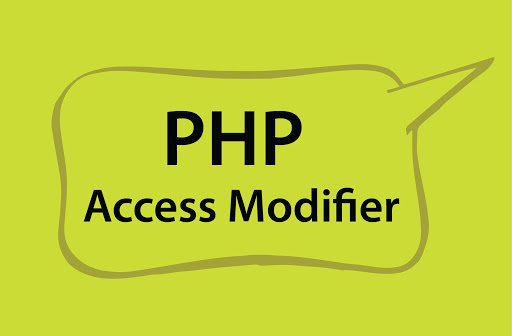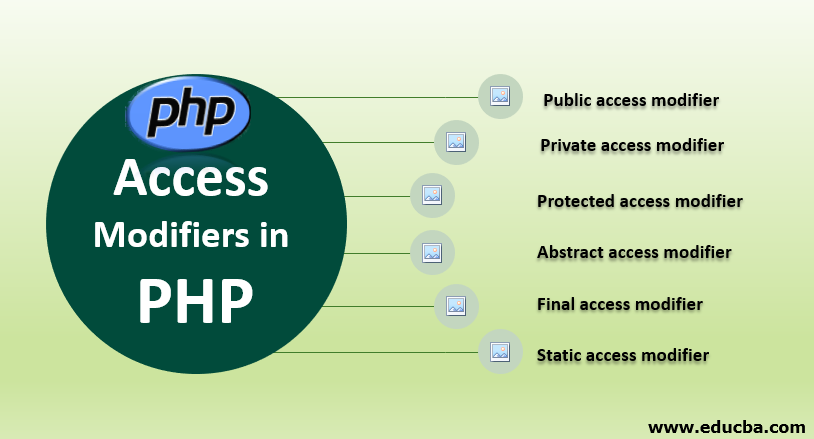
In this Tutorial, we are going to learn about Complete Tutorials of PHP OOP Access Modifiers with Example code. Through this we will learn about the concept about constructor. But first let me give you a brief explanation of what is Object-oriented programming (OOP)?
What is Object-oriented programming (OOP)
Object-oriented programming consists of combining a set of variables (properties) and functions (methods), which are referred to as an object. These things are arranged into classes in which individual items can be combined. OOP can enable you to consider the objects and the many activities in connection with the objects in a program’s code.
for more details you can go on my previous article Read More. [Object-oriented programming (OOP) Concept Simplified!]
What is Access Modifiers?

We utilize Access Modifier that is nothing more than PHP keywords to set the access permissions for class modes and variables. We can even apply some of these access modifiers to the class itself to make it behave differently. Access modifiers can be applied to properties and methods to govern where they can be accessed.
Which PHP keywords are used as Access Modifiers?
public: If we identify class members as public, they may be accessed from anywhere even outside the classroom.private: When class members are defined as private, they can only be accessible across the class.protected: This is like private class members marked as protected can still be accessible from their subclass with one exception.

What is Public Access Modifier?
The members of the class with this access Modifier will be open to the public from anywhere, including beyond the class sphere. If no access modification is indicated, all classes and their members are dealt with by default as public.
How to use the Public Access Modifier?
The Public Access Modification cannot be applied on the class itself and must be applied on the properties or processes of the class itself. To declare that a member is a public member, just insert a public keyword before the member’s statement.
| class ClassName { | |
| public $variableName; | |
| public function methodName() { | |
| } | |
| } |
Lets Understand this with a example:-
| <?php | |
| class Car { | |
| public $topSpeed; | |
| function __construct($topSpeed) { | |
| $this->topSpeed = $topSpeed; | |
| } | |
| public function drive() { | |
| return "Driving at " . $this->topSpeed . " vrooms"; | |
| } | |
| } | |
| $car1 = new Car(120); | |
| echo "Top speed for this car is " . $car1->topSpeed; | |
| ?> |
Some explanation of the examples:-
The Access Modifier keyword changes the (var) keyword in the case of an attribute.
In this case, we can immediately get to the $topSpeed attribute via the object, as its access level is publicly available.
Output:-

What is Private Access Modifier?
Within the class itself, class members are available using this keyword. With the class instance reference, it safeguards members from outside class access.
How to use the Private Access Modifier?
For class variables and methods, we may utilize the private access modifier, but not the PHP class. If a class member – a variable or a function, is designated private, the object of the class cannot be accessed directly.
| class ClassName { | |
| private $variableName; | |
| private function methodName() { | |
| } | |
| } |
Lets Understand this with a example:-
| <?php | |
| class Car { | |
| private $topSpeed; | |
| function __construct($topSpeed) { | |
| $this->topSpeed = $topSpeed; | |
| } | |
| public function drive() { | |
| return "Driving at " . $this->topSpeed . " vrooms<br>"; | |
| } | |
| } | |
| $car1 = new Car(120); | |
| echo $car1->drive(); | |
| // will raise an error if we try to access a private member | |
| echo "Top speed for this car is " . $car1->topSpeed; | |
| ?> |
Some explanation of the examples:-
In this example, the $topSpeed property may be used within the class in a drive(). Because the drive() is a public process, the object instance enables us to access it.
The interpreter will produce an error if you try to access the secret attribute directly.
Output:-

What is protected Access Modifier?
Just as private, with the exception of enabling subclasses access to members of protected superclasses.
How to use the Protected Access Modifier?
The (protected) Access Modifier is identical to the private Modifier, except that the Member is available to any child class from which this class is inherited.
| class ClassName { | |
| protected $variableName; | |
| protected function methodName() { | |
| } | |
| } |
Lets Understand this with a example:-
| <?php | |
| class ParentClass { | |
| protected $parentMsg = "protected parent attribute<br>"; | |
| protected function parentDisplay() { | |
| echo "protected parent method<br>"; | |
| echo $this->parentMsg; | |
| } | |
| } | |
| class ChildClass extends ParentClass { | |
| protected $childMsg = "Protected Child attribute.<br>"; | |
| public function childDisplay() { | |
| echo "Public Child method to display protected parent members:<br>"; | |
| $this->parentDisplay(); | |
| } | |
| } | |
| $parent = new ParentClass(); | |
| $parent->parentDisplay(); | |
| ?> |
Some explanation of the examples:-
Our ParentClass is tagged as protected by both its members in the examples above. Like the private modifier, the interpreter makes an error when we attempt to access the protected members.
We are allowed to access the protected ParentClass members inside the ChildClass.
| <?php | |
| class ParentClass { | |
| protected $parentMsg = "protected parent attribute<br>"; | |
| protected function parentDisplay() { | |
| echo "protected parent method<br>"; | |
| echo $this->parentMsg; | |
| } | |
| } | |
| class ChildClass extends ParentClass { | |
| protected $childMsg = "Protected Child attribute.<br>"; | |
| public function childDisplay() { | |
| echo "Public Child method to display protected parent members:<br>"; | |
| $this->parentDisplay(); | |
| } | |
| } | |
| $child = new ChildClass(); | |
| $child->childDisplay(); | |
| ?> |
Some explanation of the examples:-
In the preceding example, our attribute $topSpeed is designated privately, but we may use public accessor and mutator methods to obtain or set its value.
Output:-

Why do we need access modifiers?
To limit the modifications that code from outside the classes can make to the classes’ methods and properties, we require (access modifiers). Only methods within the class can reach the subject if we declare a property or function as private. Therefore, we need to provide public ways for interacting with private methods and properties. Within these methods, we may use logic to check and restrict data from outside the class.
Conclusion:-
So far, we’ve learned about two access modifiers: public, which allows code from outside the class to edit its code, and private, which prohibits code from outside the class from changing the properties and methods it protects. We showed that we may utilize public methods with the privilege to interact with code outside the scope of the class to alter private methods and properties. Hope this will help you in better way. Thank you
Email- contact@devopsschool.com

 Starting: 1st of Every Month
Starting: 1st of Every Month  +91 8409492687
+91 8409492687  Contact@DevOpsSchool.com
Contact@DevOpsSchool.com
 by
by 